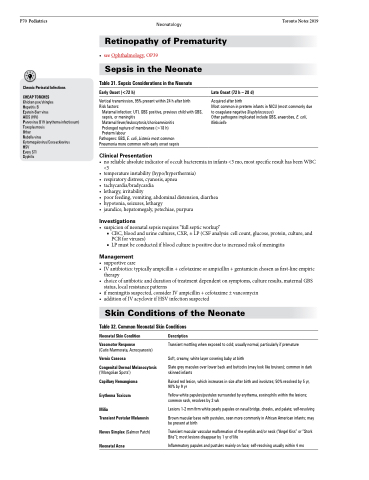Page 1104 - TNFlipTest
P. 1104
P70 Pediatrics
Neonatology
Toronto Notes 2019
Retinopathy of Prematurity
Chronic Perinatal Infections CHEAP TORCHES
Chicken pox/shingles
Hepatitis B
Epstein-Barr virus
AIDS (HIV)
Parvovirus B19 (erythema infectiosum) Toxoplasmosis
Other
Rubella virus Cytomegalovirus/Coxsackievirus HSV
Every STI
Syphilis
• seeOphthalmology,OP39
Sepsis in the Neonate
Table 31. Sepsis Considerations in the Neonate
Early Onset (<72 h)
Vertical transmission, 95% present within 24 h after birth Risk factors:
Maternal infection: UTI, GBS positive, previous child with GBS, sepsis, or meningitis
Maternal fever/leukocytosis/chorioamnionitis
Prolonged rupture of membranes (>18 h)
Preterm labour
Pathogens: GBS, E. coli, Listeria most common Pneumonia more common with early onset sepsis
Clinical Presentation
Late Onset (72 h – 28 d)
Acquired after birth
Most common in preterm infants in NICU (most commonly due to coagulase negative Staphylococcus)
Other pathogens implicated include GBS, anaerobes, E. coli, Klebsiella
• noreliableabsoluteindicatorofoccultbacteremiaininfants<3mo,mostspecificresulthasbeenWBC <5
• temperatureinstability(hypo/hyperthermia)
• respiratorydistress,cyanosis,apnea
• tachycardia/bradycardia
• lethargy, irritability
• poorfeeding,vomiting,abdominaldistension,diarrhea
• hypotonia, seizures, lethargy
• jaundice, hepatomegaly, petechiae, purpura
Investigations
• suspicionofneonatalsepsisrequires“fullsepticworkup”
■ CBC, blood and urine cultures, CXR, ± LP (CSF analysis: cell count, glucose, protein, culture, and
PCR for viruses)
■ LP must be conducted if blood culture is positive due to increased risk of meningitis
Management
• supportivecare
• IVantibiotics:typicallyampicillin+cefotaximeorampicillin+gentamicinchosenasfirst-lineempiric
therapy
• choiceofantibioticanddurationoftreatmentdependentonsymptoms,cultureresults,maternalGBS
status, local resistance patterns
• ifmeningitissuspected,considerIVampicillin+cefotaxime±vancomycin
• additionofIVacyclovirifHSVinfectionsuspected
Skin Conditions of the Neonate
Table 32. Common Neonatal Skin Conditions
Neonatal Skin Condition
Vasomotor Response
(Cutis Marmorata, Acrocyanosis)
Vernix Caseosa
Congenital Dermal Melanocytosis
(‘Mongolian Spots’)
Capillary Hemangioma Erythema Toxicum
Milia
Transient Pustular Melanosis
Nevus Simplex (Salmon Patch) Neonatal Acne
Description
Transient mottling when exposed to cold; usually normal, particularly if premature
Soft, creamy, white layer covering baby at birth
Slate grey macules over lower back and buttocks (may look like bruises); common in dark skinned infants
Raised red lesion, which increases in size after birth and involutes; 50% resolved by 5 yr, 90% by 9 yr
Yellow-white papules/pustules surrounded by erythema, eosinophils within the lesions; common rash, resolves by 2 wk
Lesions 1-2 mm firm white pearly papules on nasal bridge, cheeks, and palate; self-resolving
Brown macular base with pustules, seen more commonly in African American infants; may be present at birth
Transient macular vascular malformation of the eyelids and/or neck (“Angel Kiss” or “Stork Bite”); most lesions disappear by 1 yr of life
Inflammatory papules and pustules mainly on face; self-resolving usually within 4 mo


